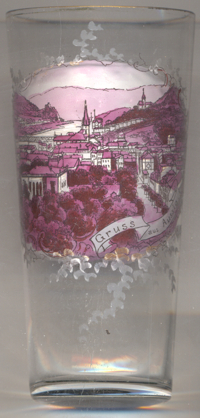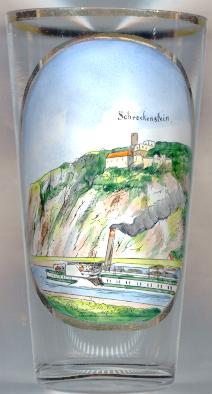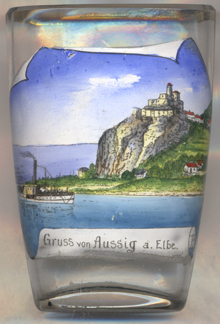

|
| ČESKÁ REPUBLIKA | CZECH REPUBLIC |
| Ústecký kraj | Ústí nad Labem region |
| Okres: Ústí nad Labem |
Ústí nad Labem (German: Aussig an der Elbe) is situated at an elevation of 144 m where the river Bílina (Biela) flows into the river Labe (Elbe), about 71 km northwest of Prague. The municipality has a population of about 92,000 (2023). It is the capital of the Ústí nad Labem region of northwestern Bohemia.
 The place was first mentioned in a document of AD 992.
and already one year later is mentioned as a toll station at a trading route.
From 1140 on, many settlers from Frankonia, Thuringia and Saxony came into the country. In 1228
Ústí obtained the status of a town and soon after, in 1246, received a charter according to German law.
The first document issued by the town in a language other than Latin (German) was written in 1328.
During the Hussite Wars, Ústí was besieged and occupied by the Hussites in 1425/1426.
The discovery around 1760 of coal in the region changed much for the town. Until the 29th century
Ústí developed into one of the most important centres of coal trading in the Austro-Hungarian Monarchy.
The opening of the railway lines from Ústí to Lovosice (Lobositz) in 1850 and to Podmokly (Bodenbach,
see Děčín) in 1851
(both part of the railroad from Prague to Dresden),
and the opening of the new Elbe harbour in 1864 boosted the industrialisation of Ústí in the late 19th century.
In the last decade of Austria-Hungary, in 1910, Ústí had about 28,300 inhabitants, of which 98% were German-speaking.
After World War I, Ústí became part of Czechoslovakia. In 1938/1939, the northern, western and southern regions of
Bohemia with German population (Sudetenland) were annexed to the Third Reich (see map).
After World War II the regions were returned to Czechoslovakia, but all the German-speaking people were
expropriated and expelled. Today, Ústí nad Labem is the capital of the Ústecký kraj region (Northwest Bohemia)
and has a population of about 96,000.
The place was first mentioned in a document of AD 992.
and already one year later is mentioned as a toll station at a trading route.
From 1140 on, many settlers from Frankonia, Thuringia and Saxony came into the country. In 1228
Ústí obtained the status of a town and soon after, in 1246, received a charter according to German law.
The first document issued by the town in a language other than Latin (German) was written in 1328.
During the Hussite Wars, Ústí was besieged and occupied by the Hussites in 1425/1426.
The discovery around 1760 of coal in the region changed much for the town. Until the 29th century
Ústí developed into one of the most important centres of coal trading in the Austro-Hungarian Monarchy.
The opening of the railway lines from Ústí to Lovosice (Lobositz) in 1850 and to Podmokly (Bodenbach,
see Děčín) in 1851
(both part of the railroad from Prague to Dresden),
and the opening of the new Elbe harbour in 1864 boosted the industrialisation of Ústí in the late 19th century.
In the last decade of Austria-Hungary, in 1910, Ústí had about 28,300 inhabitants, of which 98% were German-speaking.
After World War I, Ústí became part of Czechoslovakia. In 1938/1939, the northern, western and southern regions of
Bohemia with German population (Sudetenland) were annexed to the Third Reich (see map).
After World War II the regions were returned to Czechoslovakia, but all the German-speaking people were
expropriated and expelled. Today, Ústí nad Labem is the capital of the Ústecký kraj region (Northwest Bohemia)
and has a population of about 96,000.


 Střekov (Schreckenstein) castle, high on a rock
100 m above the right bank of the Labe (Elbe) river, was first mentioned in 1319. It originally served
as a stronghold protecting the trading route along the river.
From 1601 until 1948 the castle was a property of the Lobkowicz family.
Already by the early 17th century the castle had fallen into decay.
During the 19th century the ruins inspired many
artists such as the painters Adrian Ludwig Richter and Ernst Gustav Doerell, the composer Richard Wagner, or
the poets (Karl) Theodor Körner and Karel Hynek Mácha. Renovations in 1911/1912 aimed at securing the
remaining structures. A restaurant was opened in the castle in 1930.
After the Velvet Revolution of 1989 the castle was restituted to the previous
owners, the family of Prince Lobkowicz.
Střekov (Schreckenstein) castle, high on a rock
100 m above the right bank of the Labe (Elbe) river, was first mentioned in 1319. It originally served
as a stronghold protecting the trading route along the river.
From 1601 until 1948 the castle was a property of the Lobkowicz family.
Already by the early 17th century the castle had fallen into decay.
During the 19th century the ruins inspired many
artists such as the painters Adrian Ludwig Richter and Ernst Gustav Doerell, the composer Richard Wagner, or
the poets (Karl) Theodor Körner and Karel Hynek Mácha. Renovations in 1911/1912 aimed at securing the
remaining structures. A restaurant was opened in the castle in 1930.
After the Velvet Revolution of 1989 the castle was restituted to the previous
owners, the family of Prince Lobkowicz.
![[scale]](lineal.jpg)